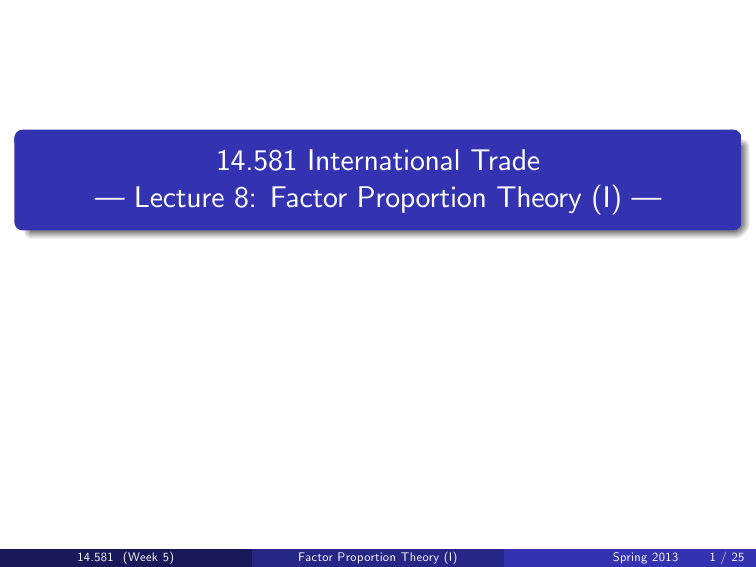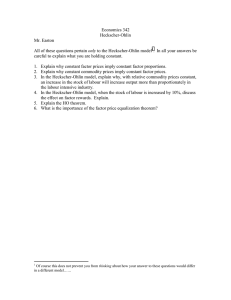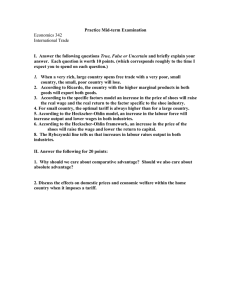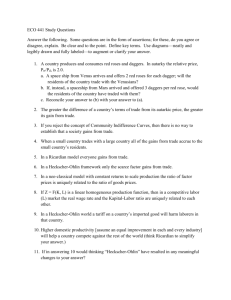14.581 International Trade — Lecture 8: Factor Proportion Theory (I) — 14.581
advertisement

14.581 International Trade — Lecture 8: Factor Proportion Theory (I) — 14.581 Week 5 Spring 2013 14.581 (Week 5) Factor Proportion Theory (I) Spring 2013 1 / 25 Today’s Plan 1 Factor Proportion Theory 2 Ricardo-Viner model 1 2 3 Basic environment Comparative statics Two-by-Two Heckscher-Ohlin model 1 2 Basic environment Classical results: 1 2 3 Factor Price Equalization Theorem Stolper-Samuelson (1941) Theorem Rybczynski (1965) Theorem 14.581 (Week 5) Factor Proportion Theory (I) Spring 2013 2 / 25 Factor Proportion Theory The law of comparative advantage establishes the relationship between relative autarky prices and trade ‡ows But where do relative autarky prices come from? Factor proportion theory emphasizes factor endowment di¤erences Key elements: 1 2 Countries di¤er in terms of factor abundance [i.e relative factor supply] Goods di¤er in terms of factor intensity [i.e relative factor demand] Interaction between 1 and 2 will determine di¤erences in relative autarky prices, and in turn, the pattern of trade 14.581 (Week 5) Factor Proportion Theory (I) Spring 2013 3 / 25 Factor Proportion Theory In order to shed light on factor endowments as a source of CA, we will assume that: 1 2 Production functions are identical around the world Households have identical homothetic preferences around the world We will …rst focus on two special models: Ricardo-Viner with 2 goods, 1 “mobile” factor (labor) and 2 “immobile” factors (sector-speci…c capital) Heckscher-Ohlin with 2 goods and 2 “mobile” factors (labor and capital) The second model is often thought of as a long-run version of the …rst (Neary 1978) In the case of Heckscher-Ohlin, what it is the time horizon such that one can think of total capital as …xed in each country, though freely mobile across sectors? 14.581 (Week 5) Factor Proportion Theory (I) Spring 2013 4 / 25 Ricardo-Viner Model Basic environment Consider an economy with: Two goods, g = 1, 2 Three factors with endowments l, k1 , and k2 Output of good g is given by yg = f g (lg , kg ) , where: lg is the (endogenous) amount of labor in sector g f g is homogeneous of degree 1 in (lg , kg ) Comments: l is a “mobile” factor in the sense that it can be employed in all sectors k1 and k2 are “immobile” factors in the sense that they can only be employed in one of them Model is isomorphic to DRS model: yg = f g (lg ) with fllg < 0 Payments to speci…c factors under CRS pro…ts under DRS 14.581 (Week 5) Factor Proportion Theory (I) Spring 2013 5 / 25 Ricardo-Viner Model Equilibrium (I): small open economy We denote by: p1 and p2 the prices of goods 1 and 2 w , r1 , and r2 the prices of l, k1 , and k2 For now, (p1 , p2 ) is exogenously given: “small open economy” So no need to look at good market clearing Pro…t maximization: pg fl g (lg , kg ) = w (1) pg fkg (lg , kg ) = rg (2) l = l1 + l2 (3) Labor market clearing: 14.581 (Week 5) Factor Proportion Theory (I) Spring 2013 6 / 25 Ricardo-Viner Model Graphical analysis p1fl1(l1,k1) p2fl2(l2,k2) w O1 l1 l2 O2 l Equations (1) and (3) jointly determine labor allocation and wage How do we recover payments to the speci…c factor from this graph? 14.581 (Week 5) Factor Proportion Theory (I) Spring 2013 7 / 25 Ricardo-Viner Model Comparative statics p1fl1(l1,k1) p2fl2(l2,k2) w O1 l1 l2 O2 l Consider a TOT shock such that p1 increases: w %, l1 %, and l2 & Condition (2) ) r1 /p1 % whereas r2 (and a fortiori r2 /p1 ) & 14.581 (Week 5) Factor Proportion Theory (I) Spring 2013 8 / 25 Ricardo-Viner Model Comparative statics One can use the same type of arguments to analyze consequences of: Productivity shocks Changes in factor endowments In all cases, results are intuitive: “Dutch disease” (Boom in export sectors, Bids up wages, which leads to a contraction in the other sectors) Useful political-economy applications (Grossman and Helpman 1994) Easy to extend the analysis to more than 2 sectors: Plot labor demand in one sector vs. rest of the economy 14.581 (Week 5) Factor Proportion Theory (I) Spring 2013 9 / 25 Ricardo-Viner Model Equilibrium (II): two-country world Predictions on the pattern of trade in a two-country world depend on whether di¤erences in factor endowments come from: Di¤erences in the relative supply of speci…c factors Di¤erences in the relative supply of mobile factors Accordingly, any change in factor prices is possible as we move from autarky to free trade (see Feenstra Problem 3.1 p. 98) 14.581 (Week 5) Factor Proportion Theory (I) Spring 2013 10 / 25 Two-by-Two Heckscher-Ohlin Model Basic environment Consider an economy with: Two goods, g = 1, 2, Two factors with endowments l and k Output of good g is given by yg = f g (lg , kg ) , where: lg , kg are the (endogenous) amounts of labor and capital in sector g f g is homogeneous of degree 1 in (lg , kg ) 14.581 (Week 5) Factor Proportion Theory (I) Spring 2013 11 / 25 Two-by-Two Heckscher-Ohlin Model Back to the dual approach cg ( w , r ) unit cost function in sector g cg (w , r ) = min fwl + rk jf g (l, k ) l ,k 1g , where w and r the price of labor and capital afg (w , r ) unit demand for factor f in the production of good g Using the Envelope Theorem, it is easy to check that: alg (w , r ) = A (w , r ) 14.581 (Week 5) dcg (w , r ) dcg (w , r ) and akg (w , r ) = dw dr [afg (w , r )] denotes the matrix of total factor requirements Factor Proportion Theory (I) Spring 2013 12 / 25 Two-by-Two Heckscher-Ohlin Model Equilibrium conditions (I): small open economy Like in RV model, we …rst look at the case of a “small open economy” So no need to look at good market clearing Pro…t-maximization: walg (w , r ) + rakg (w , r ) for all g = 1, 2 pg pg (4) = walg (w , r ) + rakg (w , r ) if g is produced in equilibrium(5) Factor market-clearing: = y1 al 1 (w , r ) + y2 al 2 (w , r ) k = y1 ak 1 (w , r ) + y2 ak 2 (w , r ) l 14.581 (Week 5) Factor Proportion Theory (I) (6) (7) Spring 2013 13 / 25 Two-by-Two Heckscher-Ohlin Model Factor Price Equalization Question: Can trade in goods be a (perfect) substitute for trade in factors? First classical result from the HO literature answers by the a¢ rmative To establish this result formally, we’ll need the following de…nition: De…nition. Factor Intensity Reversal (FIR) does not occur if: (i ) al 1 (w , r ) ak 1 (w , r ) > al 2 (w , r ) ak 2 (w , r ) for all (w , r ); or (ii ) al 1 (w , r ) ak 1 (w , r ) < al 2 (w , r ) ak 2 (w , r ) for all (w , r ). 14.581 (Week 5) Factor Proportion Theory (I) Spring 2013 14 / 25 Two-by-Two Heckscher-Ohlin Model Factor Price Insensitivity (FPI) Lemma If both goods are produced in equilibrium and FIR does not occur, then factor prices ω (w , r ) are uniquely determined by good prices p (p1 , p2 ) Proof: If both goods are produced in equilibrium, then p = A0 (ω )ω. By Gale and Nikaido (1965), this equation admits a unique solution if afg (ω ) > 0 for all f ,g and det [A (ω )] 6= 0 for all ω, which is guaranteed by no FIR. Comments: Good prices rather than factor endowments determine factor prices In a closed economy, good prices and factor endowments are, of course, related, but not for a small open economy All economic intuition can be gained by simply looking at Leontie¤ case Proof already suggests that “dimensionality” will be an issue for FIR 14.581 (Week 5) Factor Proportion Theory (I) Spring 2013 15 / 25 Two-by-Two Heckscher-Ohlin Model Factor Price Insensitivity (FPI): graphical analysis Link between no FIR and FPI can be seen graphically: r r1 p1=c1(w,r) a1 (w1,r1) a2 (w1,r1) a2 (w2,r2) a1 (w2,r2) r2 p2= c2 (w,r) w1 w2 w If iso-cost curves cross more than once, then FIR must occur 14.581 (Week 5) Factor Proportion Theory (I) Spring 2013 16 / 25 Heckscher-Ohlin Model Factor Price Equalization (FPE) Theorem The previous lemma directly implies (Samuelson 1949) that: FPE Theorem If two countries produce both goods under free trade with the same technology and FIR does not occur, then they must have the same factor prices Comments: Trade in goods can be a “perfect substitute” for trade in factors Countries with di¤erent factor endowments can sustain same factor prices through di¤erent allocation of factors across sectors Assumptions for FPE are stronger than for FPI: we need free trade and same technology in the two countries... For next results, we’ll maintain assumption that both goods are produced in equilibrium, but won’t need free trade and same technology 14.581 (Week 5) Factor Proportion Theory (I) Spring 2013 17 / 25 Heckscher-Ohlin Model Stolper-Samuelson (1941) Theorem Stolper-Samuelson Theorem An increase in the relative price of a good will increase the real return to the factor used intensively in that good, and reduced the real return to the other factor Proof: W.l.o.g. suppose that (i ) al 1 (ω ) ak 1 (ω ) > al 2 (ω ) ak 2 (ω ) and (ii ) p b2 > p b1 . Di¤erentiating the zero-pro…t condition (5), we get p bg = θ lg w b + (1 θ lg ) b r, p b1 , p b2 p b1 , p b2 where b x = d ln x and θ lg w b (8) walg (ω ) /cg (ω ). Equation (8) implies b r or b r w b By (i ), θ l 2 < θ l 1 . So (i ) requires b r >w b . Combining the previous inequalities, we get b r >p b2 > p b1 > w b 14.581 (Week 5) Factor Proportion Theory (I) Spring 2013 18 / 25 Heckscher-Ohlin Model Stolper-Samuelson (1941) Theorem Comments: Previous “hat” algebra is often referred to “Jones’(1965) algebra” The chain of inequalities b r >p b2 > p b1 > w b is referred as a “magni…cation e¤ect” SS predict both winners and losers from change in relative prices Like FPI and FPE, SS entirely comes from zero-pro…t condition (+ no joint production) Like FPI and FPE, sharpness of the result hinges on “dimensionality” In the empirical literature, people often talk about “Stolper-Samuelson e¤ects” whenever looking at changes in relative factor prices (though changes in relative good prices are rarely observed) 14.581 (Week 5) Factor Proportion Theory (I) Spring 2013 19 / 25 Heckscher-Ohlin Model Stolper-Samuelson (1941) Theorem: graphical analysis r p1=c1(w,r) p2= c2 (w,r) w Like for FPI and FPE, all economic intuition could be gained by looking at the simpler Leontie¤ case: In the general case, iso-cost curves are not straight lines, but under no FIR, same logic applies 14.581 (Week 5) Factor Proportion Theory (I) Spring 2013 20 / 25 Two-by-Two Heckscher-Ohlin Model Rybczynski (1965) Theorem Previous results have focused on the implication of zero pro…t condition, Equation (5), for factor prices We now turn our attention to the implication of factor market clearing, Equations (6) and (7), for factor allocation Rybczynski Theorem An increase in factor endowment will increase the output of the industry using it intensively, and decrease the output of the other industry 14.581 (Week 5) Factor Proportion Theory (I) Spring 2013 21 / 25 Two-by-Two Heckscher-Ohlin Model Rybczynski (1965) Theorem Proof: W.l.o.g. suppose that (i ) al 1 (ω ) ak 1 (ω ) > al 2 (ω ) ak 2 (ω ) and (ii ) kb > bl. Di¤erentiating factor market clearing conditions (6) and (7), we get where λl 1 implies bl = λl 1 yb1 + (1 kb = λk 1 yb1 + (1 al 1 (ω ) y1 /l and λk 1 yb1 bl, kb λl 1 ) yb2 (9) λk 1 ) yb2 (10) ak 1 (ω ) y1 /k. Equations (8) yb2 or yb2 bl, kb yb1 By (i ), λk 1 < λl 1 . So (ii ) requires yb2 > yb1 . Combining the previous inequalities, we get yb2 > kb > bl > yb1 14.581 (Week 5) Factor Proportion Theory (I) Spring 2013 22 / 25 Two-by-Two Heckscher-Ohlin Model Rybczynski (1965) Theorem Like for FPI and FPE Theorems: (p1 , p2 ) is exogenously given ) factor prices and factor requirements are not a¤ected by changes factor endowments Empirically, Rybczynski Theorem suggests that impact of immigration may be very di¤erent in closed vs. open economy Like for SS Theorem, we have a “magni…cation e¤ect” Like for FPI, FPE, and SS Theorems, sharpness of the result hinges on “dimensionality” 14.581 (Week 5) Factor Proportion Theory (I) Spring 2013 23 / 25 Two-by-Two Heckscher-Ohlin Model Rybczynski (1965) Theorem: graphical analysis (I) Since good prices are …xed, it is as if we were in Leontie¤ case y2 l=al1 y1+ al2y2 k=ak1 y1+ ak2y2 y1 14.581 (Week 5) Factor Proportion Theory (I) Spring 2013 24 / 25 Two-by-Two Heckscher-Ohlin Model Rybczynski (1965) Theorem: graphical analysis (II) Rybczynski e¤ect can also be illustrated using relative factor supply and relative factor demand: r/l RD1 RD2 RS K/L Cross-sectoral reallocations are at the core of HO predictions: For relative factor prices to remain constant, aggregate relative demand must go up, which requires expansion capital intensive sector 14.581 (Week 5) Factor Proportion Theory (I) Spring 2013 25 / 25 MIT OpenCourseWare http://ocw.mit.edu 14.581 International Economics I Spring 2013 For information about citing these materials or our Terms of Use, visit: http://ocw.mit.edu/terms.



